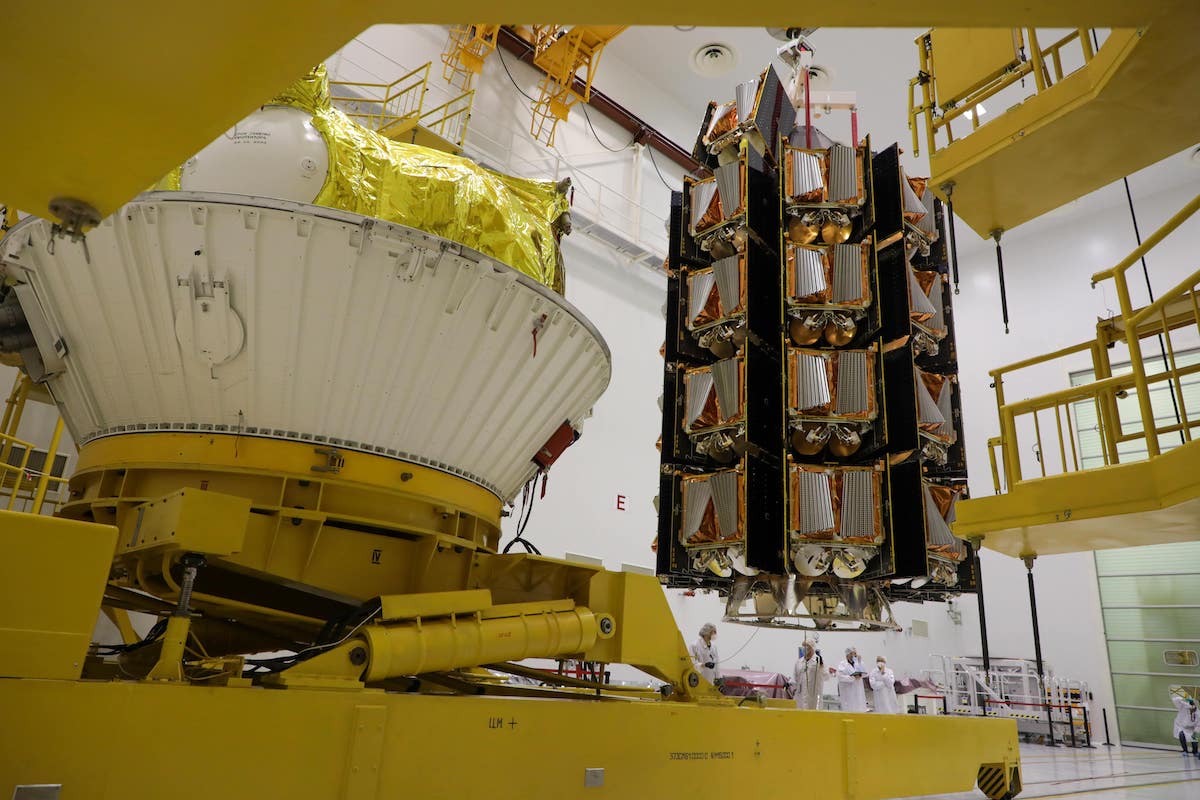
A day after SpaceX launched 51 Starlink broadband satellites from California, a Russian Soyuz rocket fired into orbit Tuesday from a spaceport halfway around the world, shepherding 34 more satellites for the commercial internet network being constructed by rival OneWeb.
The back-to-back missions continue the rapid deployment of the dueling internet networks, with more Starlink and OneWeb launches scheduled next month.
OneWeb’s launch took off from the Baikonur Cosmodrome in Kazakhstan at 2:07:19 p.m. EDT (1807:19 GMT; 11:07:19 p.m. Baikonur time). The 34 satellites rode a Soyuz-2.1b launcher and a Fregat upper stage into orbit.
The kerosene-fueled Soyuz fired away from Baikonur on a northerly heading to reach a 280-mile-high (450-kilometer) polar orbit.
Less than 10 minutes after liftoff, the Soyuz rocket’s third stage shut down and deployed the Fregat upper stage. The Fregat, fed by a mix of storable hydrazine and nitrogen tetroxide propellants, fired its main engine two times to place the 34 satellite into the targeted orbit, according to Roscosmos, the Russian space agency.
Tuesday’s launch marked the 100th flight of a Fregat upper stage since 2000. The space tug, designed for orbital maneuvers to place satellites into different types of orbits, is built by the Russian company NPO Lavochkin.
The satellites, each the size of a mini-refrigerator, released from a dispenser on the Fregat upper stage in groups of two and four over the course of several hours. Within four hours of launch, all 34 satellites were deployed, and OneWeb confirmed each of the spacecraft transmitted signals to mission control, confirming their health after arriving in space.
With the new satellites, OneWeb has launched 322 spacecraft on 10 Soyuz rockets since February 2019, nearly half of the company’s planned fleet of 648 internet satellites.
The OneWeb spacecraft are built by OneWeb Satellites, a joint venture between OneWeb and Airbus, in a factory just outside the gate of NASA’s Kennedy Space Center in Florida.
The satellites, each fitted with a xenon-fueled ion thruster, beam broadband internet signals to users on the ground, at sea, or in the air, providing high-speed, low-latency connectivity for consumers, large companies, and governments. OneWeb is competing with SpaceX’s Starlink network, along with planned internet constellations from other companies.
So far, the pace of launches for the Starlink network has outrun efforts by SpaceX’s competitors.
SpaceX has authorization from the Federal Communications Commission to eventually launch and operate 12,000 Starlink satellites. The company has launched 1,791 Starlink satellites to date.
The OneWeb satellites fly at higher altitudes than the Starlink spacecraft. The difference in architecture means OneWeb can reach global internet coverage with 648 satellites, a significantly smaller constellation than Starlink.
Amazon is planning its own commercial satellite internet constellation, but hasn’t started launching. China is also developing a broadband network that could include thousands of small satellites.
A Soyuz launch in July gave OneWeb enough spacecraft to provide internet services to customers north of 50 degrees latitude, once the satellites move into their proper orbital planes and complete testing. Another 34 OneWeb satellites launched Aug. 21 from Baikonur.
OneWeb filed for bankruptcy in March 2020 after failing to secure enough funding to continue building and launching satellites. The reorganized company emerged from bankruptcy last year under the ownership of Bharti Global and the UK government.
OneWeb announced Aug. 12 a $300 million equity investment from Hanwha, a South Korean tech and manufacturing firm. The funding brings the total equity investment in OneWeb since November 2020 to $2.7 billion, the company said.
Neil Masterson, CEO of OneWeb, said last month that the company has enough funding to complete its 648-satellite constellation by next year.

Masterson sees strong demand for internet connectivity, a market that is driving billions of dollars in private investment in networks like OneWeb and Starlink.
“We don’t know yet quite how big that demand is, and we don’t know how many participants in the marketplace that will support, but I think it’s a lot bigger than people think,” Masterson said in a panel discussion at the Space Symposium.
“There are millions and billions of people that do not have access to decent internet,” said Gwynne Shotwell, SpaceX’s president and chief operating officer. “So that’s a pretty big market. I am not worried about the number of organizations that are interested in doing this. I’m interested and concerned about their sustainability when it comes to the space environment.”
OneWeb hopes to begin internet service to users above 50 degrees north latitude by the end of this year. Global service should begin in 2022, OneWeb says.
Arianespace is OneWeb’s launch provider. The French company is responsible for managing procurement of Soyuz rockets and Fregat upper stages from Russian industry.
OneWeb’s contract with Arianespace covers 19 Soyuz launches. With 10 missions complete, nine more launches are planned over the next year.
The next Soyuz flight for OneWeb is set for liftoff Oct. 14 from the Vostochny Cosmodrome in Russia’s Far East.
Email the author.
Follow Stephen Clark on Twitter: @StephenClark1.
